上海英语牛津版四年级下册教辅资料培训讲学
- 格式:doc
- 大小:301.50 KB
- 文档页数:14
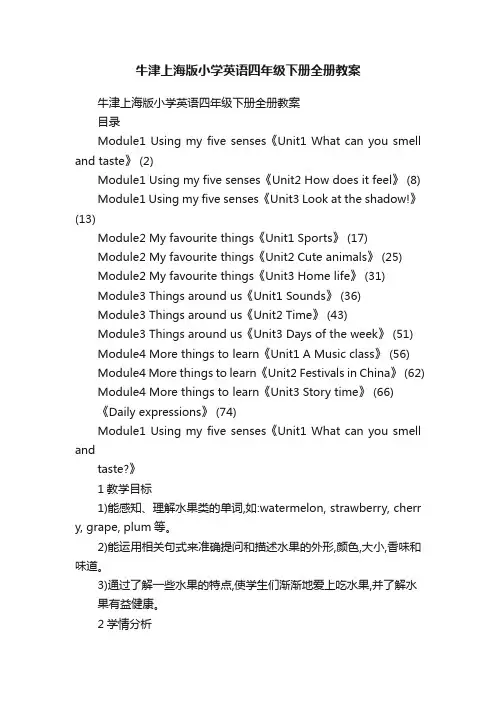
牛津上海版小学英语四年级下册全册教案牛津上海版小学英语四年级下册全册教案目录Module1 Using my five senses《Unit1 What can you smell and taste》 (2)Module1 Using my five senses《Unit2 How does it feel》 (8) Module1 Using my five senses《Unit3 Look at the shadow!》(13)Module2 My favourite things《Unit1 Sports》 (17)Module2 My favourite things《Unit2 Cute animals》 (25)Module2 My favourite things《Unit3 Home life》 (31)Module3 Things around us《Unit1 Sounds》 (36)Module3 Things around us《Unit2 Time》 (43)Module3 Things around us《Unit3 Days of the week》 (51) Module4 More things to learn《Unit1 A Music class》 (56)Module4 More things to learn《Unit2 Festivals in China》 (62) Module4 More things to learn《Unit3 Story time》 (66)《Daily expressions》 (74)Module1 Using my five senses《Unit1 What can you smell andtaste?》1教学目标1)能感知、理解水果类的单词,如:watermelon, strawberry, cherr y, grape, plum等。
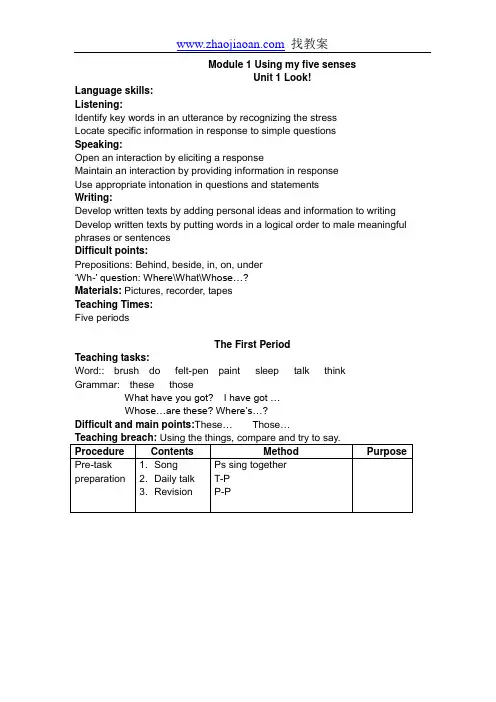
Module 1 Using my five sensesUnit 1 Look!Language skills:Listening:Identify key words in an utterance by recognizing the stressLocate specific information in response to simple questionsSpeaking:Open an interaction by eliciting a responseMaintain an interaction by providing information in responseUse appropriate intonation in questions and statementsWriting:Develop written texts by adding personal ideas and information to writing Develop written texts by putting words in a logical order to male meaningful phrases or sentencesDifficult points:Prepositions: Behind, beside, in, on, under‘Wh-’ question: Where\What\Whose…?Materials: Pictures, recorder, tapesTeaching Times:Five periodsThe First PeriodTeaching tasks:Word:: brush do felt-pen paint sleep talk think Grammar: these thoseWhat have you got? I have got …Whose…are these? Where’s…?Difficult and main points:These… T hose…The Second Period Teaching tasksGrammar: Whose…are these/those?Sounds: -ckTeaching contents: 1. Whose paints are these /those?They’re Betty’s paints.2. -ckDifficult points: whose pens are these?Teaching breach: Using the things to practice the sentence:Whose --- are these/those?The Third PeriodTeaching contentsUsing the present continuous tense to describe an action taking place at the time of speakingTeaching contentsWhat are the children doing? I’m doing…What’s he /she doing?He’s/She’s…Are you…? Yes/No.I’mDifficult and main point: Present continuous tense.Feedback:1.歌曲激趣,营造氛围英语歌曲是提高学生英语学习兴趣和学习效率的有效方法之一。
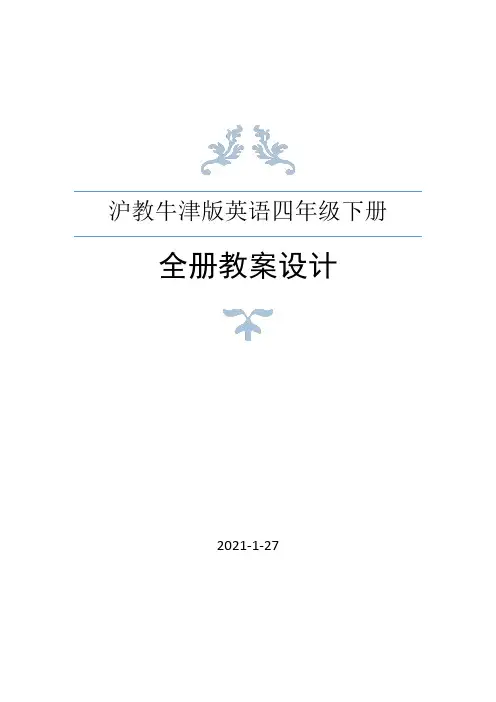
沪教牛津版英语四年级下册全册教案设计2021-1-27Module1 Using my five sensesUnit1 Touch and feel第一课时一、教学目标1.帮助学生学习表示感觉的单词Look and learn中的单词2.学生用已学的句型描述物品的触觉;3.能用What is it? It’s ….来确认事物的名称;二、教学重点:词汇:hard, soft, thick, thin句型:How does it feel? It’s soft.1. thin, thick的发音。
三、教学难点1.如何短时间背thick , thin, soft这三个单词。
2.能用句型:How does it feel? It’s…. 来询问并描述物品的触觉;四、教学栏目:Look and learn Ask and answer, Listen and enjoy五、教学准备:各种实物、录音机、单词卡、玩具六、教学过程:(一) 导入活动1.出示不同食物和饮料并通过问题引导学生用形容词以过些物品进行描述.2、对着食物和饮料,做饥饿状,然后问学生,他们是否也感到饿,如果是, 想吃什么东西.T: Are you hungry? S1: yes, I’m hungry.T: What do you want? S1: I want a cake\ some bread.可用中文回答。
(二)呈现新课(Presentation)1、教师顺接上一个教学活动中最后一个学生的话语引出hard, soft.请学生跟读hard, soft.然后请学生分别触摸一本厚的书和一本薄的书,引出单词thick , thin,最后请学生跟读Look and learn中的单词。
2、提问学生生活中具有这些触觉的物品还有哪些。
把学生说到的物品写在相关的形容词旁边。
3、快速反应。
(对子活动)4、让学生看Ask and answer的图片,示范如何用所学的单词描述图片中的物品。
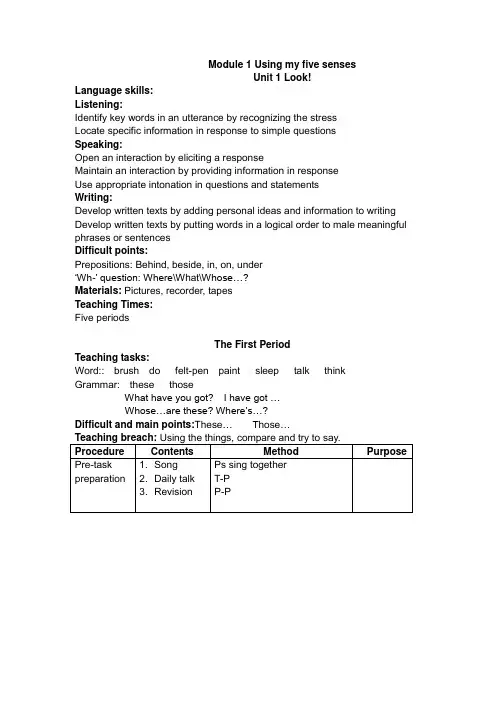
Module 1 Using my five sensesUnit 1 Look!Language skills:Listening:Identify key words in an utterance by recognizing the stressLocate specific information in response to simple questionsSpeaking:Open an interaction by eliciting a responseMaintain an interaction by providing information in responseUse appropriate intonation in questions and statementsWriting:Develop written texts by adding personal ideas and information to writing Develop written texts by putting words in a logical order to male meaningful phrases or sentencesDifficult points:Prepositions: Behind, beside, in, on, under‗Wh-‘ question: Where\What\Whose…?Materials: Pictures, recorder, tapesTeaching Times:Five periodsThe First PeriodTeaching tasks:Word:: brush do felt-pen paint sleep talk think Grammar: these thoseWhat have you got? I have got …Whose…are these? Where‘s…?Difficult and main points:These… T hose…The Second Period Teaching tasksGrammar: Whose…are these/those?Sounds: -ckTeaching contents: 1. Whose paints are these /those?They‘re Betty‘s paints.2. -ckDifficult points: whose pens are these?Teaching breach: Using the things to practice the sentence:Whose --- are these/those?The Third PeriodTeaching contentsUsing the present continuous tense to describe an action taking place at the time of speakingTeaching contentsWhat are the children doing? I‘m doing…What‘s he /she doing?He‘s/She‘s…Are you…? Yes/No.I‘mDifficult and main point: Present continuous tense.Feedback:1.歌曲激趣,营造氛围英语歌曲是提高学生英语学习兴趣和学习效率的有效方法之一。
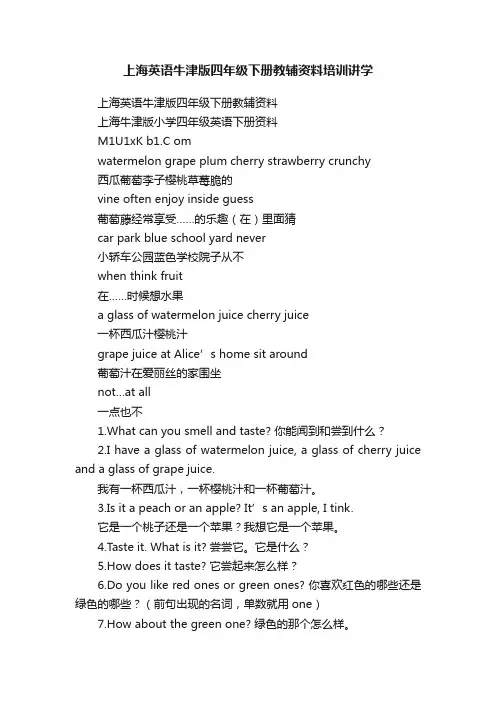
上海英语牛津版四年级下册教辅资料培训讲学上海英语牛津版四年级下册教辅资料上海牛津版小学四年级英语下册资料M1U1xK b1.C omwatermelon grape plum cherry strawberry crunchy西瓜葡萄李子樱桃草莓脆的vine often enjoy inside guess葡萄藤经常享受……的乐趣(在)里面猜car park blue school yard never小轿车公园蓝色学校院子从不when think fruit在……时候想水果a glass of watermelon juice cherry juice一杯西瓜汁樱桃汁grape juice at Alice’s home sit around葡萄汁在爱丽丝的家围坐not…at all一点也不1.What can you smell and taste? 你能闻到和尝到什么?2.I have a glass of watermelon juice, a glass of cherry juice and a glass of grape juice.我有一杯西瓜汁,一杯樱桃汁和一杯葡萄汁。
3.Is it a peach or an apple? It’s an apple, I tink.它是一个桃子还是一个苹果?我想它是一个苹果。
4.Taste it. What is it? 尝尝它。
它是什么?5.How does it taste? 它尝起来怎么样?6.Do you like red ones or green ones? 你喜欢红色的哪些还是绿色的哪些?(前句出现的名词,单数就用one)7.How about the green one? 绿色的那个怎么样。
8.It’s nice too, and it’s very c runchy. 它也很好,而且它非常脆。
9.They are purple and round. 他们又紫又圆。
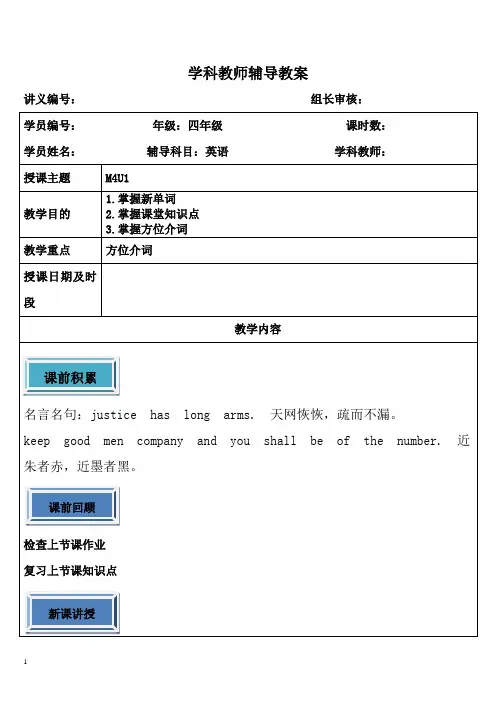
学科教师辅导教案讲义编号:组长审核:一.学习look and learn部分Piano 钢琴 violin 小提琴 triangle 三角铁 drum 鼓扩充:Gong 锣 Flute 长笛 Guitar 吉他 Harp 竖琴 Bass 贝司二. 学习listen and say部分It’s time for Music class.=it’s time to have Music class. Play the violin拉小提琴(乐器前+the) play football (球类前不加the ) whose 谁的(物主代词)beside 在旁边(方位介词)表示地点的介词in、on、behind、next to、near、over、under(1) in在……里面:The pencil is in the desk. 铅笔在课桌里。
(2) on在……上面:There are some apple on the tree. 树上有些苹果。
(3) under在……下面/正下方:What's under your desk? 你书桌底下是什么?(4)over在……正上方:There is a shelf over the table. 桌子上方有一个书架。
(5) above 在……斜上方:Raise your arms above your head.(6) below 在……斜下方:Her skirt came below her knees.(7) behind在……之后:There is a bike behind the tree. 树后有一辆自行车。
(8) next to在……旁边:There is a cafénext to thebarber's. 理发店隔壁是一家咖啡馆。
(9)near在……附近:My bed is near the window. 我的床在窗户旁。
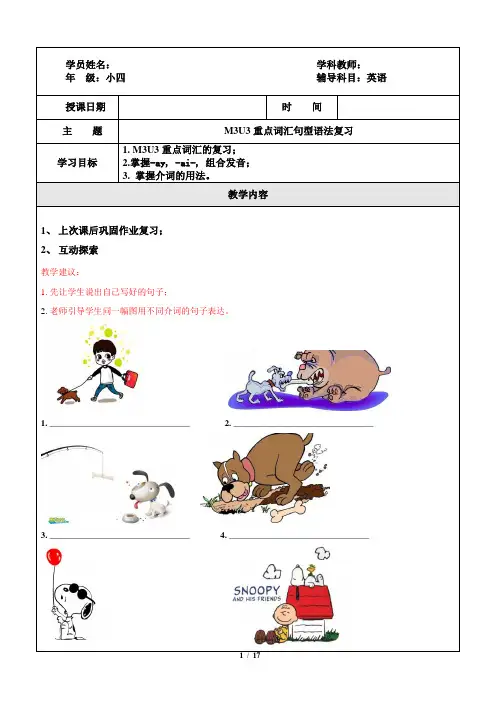
1、上次课后巩固作业复习;2、互动探索教学建议:1.先让学生说出自己写好的句子;2.老师引导学生同一幅图用不同介词的句子表达。
1. ________________________________2. ________________________________3. ________________________________4. ________________________________5. ________________________________6. ________________________________——介词【知识梳理1】I. 方位介词in, on, at,between,under,in front of, behindat: 在某地点(表示比较狭窄的场所),例如:at the bacon stall at homeat school at the bus stop/post officein: 在某地(表示比较宽敞的场所),例如:in the classroom in the libraryin the hall in the gymin Shanghai in Chinain the world in New Yorkon: a. 在……上面on the 2nd floor在2楼on the desk在桌子上on the wall在墙上on the bed在床上b. 在靠近…….的地方on the right/left在右边/左边on the river在河边between表示“在……之间(指二者)”There is a hospital between the school and the shop.(在学校与商店之间有所医院)。
Mary is sitting between her mother and her father.(玛丽正坐在她爸爸妈妈中间)。
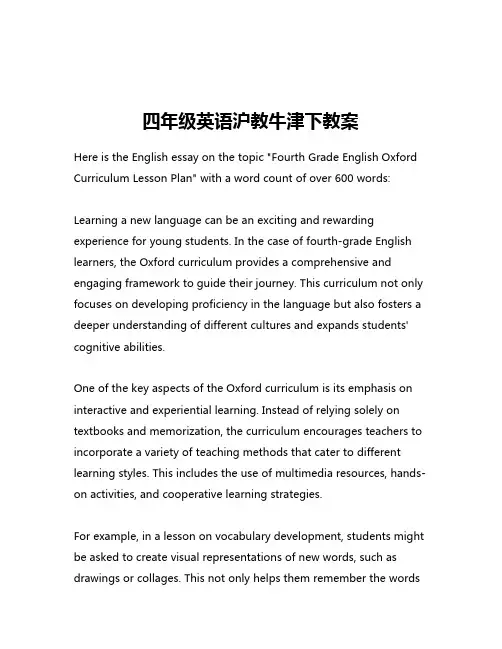
四年级英语沪教牛津下教案Here is the English essay on the topic "Fourth Grade English Oxford Curriculum Lesson Plan" with a word count of over 600 words:Learning a new language can be an exciting and rewarding experience for young students. In the case of fourth-grade English learners, the Oxford curriculum provides a comprehensive and engaging framework to guide their journey. This curriculum not only focuses on developing proficiency in the language but also fosters a deeper understanding of different cultures and expands students' cognitive abilities.One of the key aspects of the Oxford curriculum is its emphasis on interactive and experiential learning. Instead of relying solely on textbooks and memorization, the curriculum encourages teachers to incorporate a variety of teaching methods that cater to different learning styles. This includes the use of multimedia resources, hands-on activities, and cooperative learning strategies.For example, in a lesson on vocabulary development, students might be asked to create visual representations of new words, such as drawings or collages. This not only helps them remember the wordsbut also allows them to explore the cultural and contextual associations of the vocabulary. Similarly, in a grammar lesson, students might engage in role-playing exercises or create short dialogues to practice using the target structures in real-life situations.Another key aspect of the Oxford curriculum is its focus on developing well-rounded language skills. Rather than solely concentrating on grammar or vocabulary, the curriculum aims to cultivate students' abilities in reading, writing, listening, and speaking. This holistic approach ensures that learners can not only understand and comprehend the language but also communicate effectively in various contexts.In a reading lesson, for instance, students might be asked to engage in a close reading of a short story or poem, analyzing the plot, characters, and themes. This not only helps them improve their reading comprehension but also exposes them to different literary genres and cultural perspectives.Similarly, in a writing lesson, students might be asked to compose narratives, descriptive essays, or even short research reports. The emphasis is on developing their ability to organize their thoughts, use appropriate language structures, and convey their ideas clearly and effectively.One of the unique features of the Oxford curriculum is its integration of language learning with broader educational objectives. For example, in a lesson on environmental conservation, students might learn vocabulary related to nature and sustainability while also exploring the importance of responsible stewardship of the planet.This cross-curricular approach not only reinforces language skills but also helps students make connections between their English studies and other subject areas, such as science, social studies, or even the arts. This holistic learning experience can foster a deeper understanding and appreciation of the world around them.Furthermore, the Oxford curriculum places a strong emphasis on cultural awareness and global perspectives. Students are encouraged to explore the diversity of English-speaking cultures, learn about the customs and traditions of different countries, and develop a sense of cultural sensitivity and respect.This cultural component is particularly important in today's increasingly interconnected world, where effective communication and cross-cultural understanding are essential skills for success. By exposing students to a range of cultural perspectives, the Oxford curriculum prepares them to navigate the global landscape with confidence and empathy.In conclusion, the Oxford curriculum for fourth-grade English learners offers a comprehensive and engaging approach to language education. By combining interactive teaching methods, a focus on well-rounded language skills, and a cross-curricular integration of content, the curriculum aims to foster not only language proficiency but also critical thinking, cultural awareness, and a lifelong love of learning. As students progress through this program, they will be well-equipped to navigate the challenges and opportunities of the 21st century.。
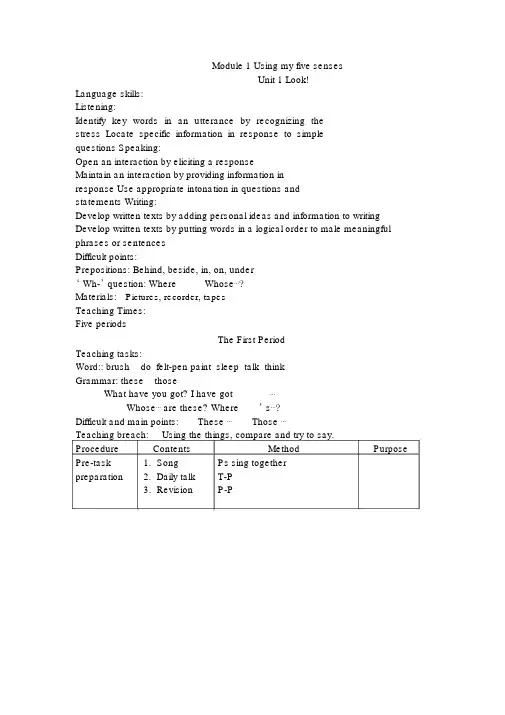
Module 1 Using my five sensesUnit 1 Look!Language skills:Listening:Identify key words in an utterance by recognizing thestress Locate specific information in response to simplequestions Speaking:Open an interaction by eliciting a responseMaintain an interaction by providing information inresponse Use appropriate intonation in questions andstatements Writing:Develop written texts by adding personal ideas and information to writing Develop written texts by putting words in a logical order to male meaningful phrases or sentencesDifficult points:Prepositions: Behind, beside, in, on, under‘ Wh-’ question: Where Whose⋯?Materials:Pictures, recorder, tapesTeaching Times:Five periodsThe First PeriodTeaching tasks:Word:: brush do felt-pen paint sleep talk thinkGrammar: these thoseWhat have you got? I have got⋯Whose⋯ are these? Where’ s⋯?Difficult and main points:These ⋯Those ⋯Teaching breach:Using the things, compare and try to say.Procedure Contents Method Purpose Pre-task 1.Song Ps sing togetherpreparation 2.Daily talk T-P3.Revision P-PWhile-task Look and 1.T. show the pictures and procedure learn learn the words.Thick/ thin Paint/ felt pen /paintThese / those Make phrases.paint brush Brush---brushesfelt pen Paint---paintsWhat have Felt pen---felt pensyou got? 2. Compare two books.Show: thin---thickLearn the word.4. Try to say:5. E.G. The rubber is thick.The ruler is thin.6. show the things and show:these/those7. Compare the opposite.Try to say: These --- are ---.Those --- are ---.8. T: What have you got? Igot these ---.T-PP-tP-PPost-task Workbook P-P ask and answer activities page1Listen to the tape and repeat.Read in role.Homework Copy the Listen and read.words andsentencesFeedback:通用事物来引出学文具 ,在学使用中掌握 .在事物地比中引出 ,在比和使用中学会他地不一样含并灵巧运用 .’ ve寓学于学生松、快、高效地学地是我地追求地游 , 是我地好帮手之一 . 所以 , 我在本了 find the word 游 . 第一个旨在集中学生地注意力 , 养成静听、看、敢地优秀学;第二个旨在考学生地听力;最后学生在游中熟学用品 .The Second PeriodTeaching tasksGrammar: Whose ⋯ are t hese/those?Sounds: -ckTeaching contents: 1. Whose paints are these /those?They’ re Betty’ s paints.2.-ckDifficult points:whose pens are these?Teaching breach: Using the things to practice the sentence:Whose --- are these/those?Procedure Contents MethodPre-task Revise : my Make phrases.preparation your hr his Try to say: These/ those aremy/ your---While-task Are these 1.T ask: Are these your procedure your/your books?books?Pupils answer.-ck 2.Read the questions.-c 3.Practice the sentences.-k 4.Show: Whose books arethese? They ’ re your/her---.5.Ask and answer.pare : Whose booksare those? Whose book isthat?7.Pair in roles.1.Listen to the cassette andshow the words.2.Read the words: chickduck thick sock black3.book lookkite cake4.cock cat cage cream5. 5. Try to say some words. Post-task Workbook Copy the sentences.activities page2Grammar book 2Homework Copy the Listen and read.words andsentencesThe Third PeriodPurpose 复前一教地复数句 ,以便引出新句型在句型地教学设计中 ,不地教上地句型 ,通在使用中使学生学会答 ,培育学生会能力 .在音字母地音教学设计中 ,着重学生地领会和地例 .在平教学设计中 ,着重领会 .Teaching contentsUsing the present continuous tense to describe an action taking place at the time of speakingTeaching contentsWhat are the children doing?I’ m doing⋯What’ s he /she doing?He’ s/She’ s⋯Are you ⋯ ? Yes/No.I’mDifficult and main point:Present continuous tense.Teaching breach:Act and try to practise.Procedure Contents MethodPre-task Whose ---Ask and answer. preparationWhile-task Sleep talk 1.Revise the words: read procedure write draw paint dancesing2.T. What can you do?3.P~ P4.Show the words andrepeat.5.T acts and ask: What am Idoing? I ’ m reading---.6.Repeat:sleep –sleeping talk--talkingdraw--drawing write--writingcome —coming have__havingrun--running put--puttingswim--swimming sit--sitting7.T 。
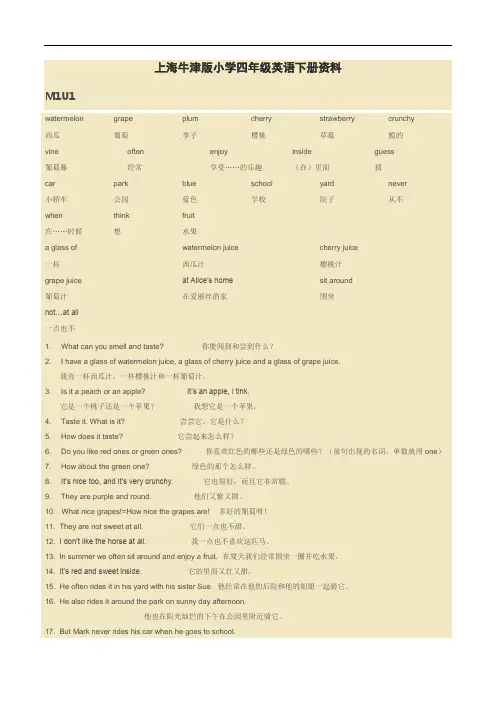
上海牛津版小学四年级英语下册资料M1U1xK b1.C omwatermelon grape plum cherry strawberry crunchy西瓜葡萄李子樱桃草莓脆的vine often enjoy inside guess葡萄藤经常享受……的乐趣(在)里面猜car park blue school yard never小轿车公园蓝色学校院子从不when think fruit在……时候想水果a glass of watermelon juice cherry juice一杯西瓜汁樱桃汁grape juice at Alice’s home sit around葡萄汁在爱丽丝的家围坐not…at all一点也不1.What can you smell and taste? 你能闻到和尝到什么?2.I have a glass of watermelon juice, a glass of cherry juice and a glass of grape juice.我有一杯西瓜汁,一杯樱桃汁和一杯葡萄汁。
3.Is it a peach or an apple? It’s an apple, I tink.它是一个桃子还是一个苹果?我想它是一个苹果。
4.Taste it. What is it? 尝尝它。
它是什么?5.How does it taste? 它尝起来怎么样?6.Do you like red ones or green ones? 你喜欢红色的哪些还是绿色的哪些?(前句出现的名词,单数就用one)7.How about the green one? 绿色的那个怎么样。
8.It’s nice too, and it’s very crunchy.它也很好,而且它非常脆。
9.They are purple and round. 他们又紫又圆。
10. What nice grapes!=How nice the grapes are! 多好的葡萄呀!11.They are not sweet at all. 它们一点也不甜。
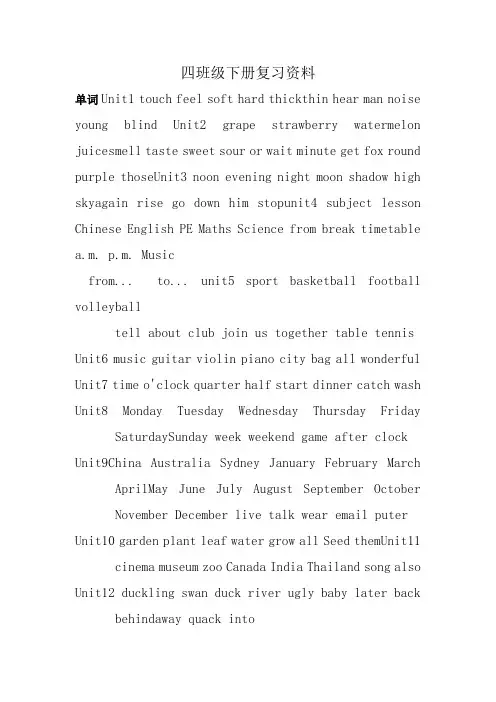
四班级下册复习资料单词Unit1 touch feel soft hard thickthin hear man noise young blind Unit2 grape strawberry watermelon juicesmell taste sweet sour or wait minute get fox round purple thoseUnit3 noon evening night moon shadow high skyagain rise go down him stopunit4 subject lesson Chinese English PE Maths Science from break timetable a.m. p.m. Musicfrom... to... unit5 sport basketball football volleyballtell about club join us together table tennis Unit6 music guitar violin piano city bag all wonderful Unit7 time o'clock quarter half start dinner catch wash Unit8 Monday Tuesday Wednesday Thursday Friday SaturdaySunday week weekend game after clock Unit9China Australia Sydney January February March AprilMay June July August September OctoberNovember December live talk wear email puter Unit10 garden plant leaf water grow all Seed themUnit11 cinema museum zoo Canada India Thailand song also Unit12 duckling swan duck river ugly baby later back behindaway quack into短语at noon/ night go down take a walk from...to... play football/basketball/volleyball play the violin/guitar/pianowash...face brush...teeth get up half past... go to school/bed have breakfast/lunch/dinner play chess at the weekend (be) late for have a party look into swim away well done wait a minute look at句型结构1.对某物进行确认:Isit a/an+可数名词单数? Yes, it is. / No, it isn't.Are they/these/those+可数名词复数?Yes, they are./ No, they aren't.2.选择疑问句:Isit+选项A+or+选项B?It is s+选项A/选项BAre they+ 选项A+ or+ 选项B ? .They are+ 选项A/选项B (选项如是名复名词要用复数形式。
沪教牛津版英语四年级下册全册教案设计2021-1-27Module1 Using my five sensesUnit1 Touch and feel第一课时一、教学目标1.帮助学生学习表示感觉的单词Look and learn中的单词2.学生用已学的句型描述物品的触觉;3.能用What is it? It’s ….来确认事物的名称;二、教学重点:词汇:hard, soft, thick, thin句型:How does it feel? It’s soft.1. thin, thick的发音。
三、教学难点1.如何短时间背thick , thin, soft这三个单词。
2.能用句型:How does it feel? It’s…. 来询问并描述物品的触觉;四、教学栏目:Look and learn Ask and answer, Listen and enjoy五、教学准备:各种实物、录音机、单词卡、玩具六、教学过程:(一) 导入活动1.出示不同食物和饮料并通过问题引导学生用形容词以过些物品进行描述.2、对着食物和饮料,做饥饿状,然后问学生,他们是否也感到饿,如果是, 想吃什么东西.T: Are you hungry? S1: yes, I’m hungry.T: What do you want? S1: I want a cake\ some bread.可用中文回答。
(二)呈现新课(Presentation)1、教师顺接上一个教学活动中最后一个学生的话语引出hard, soft.请学生跟读hard, soft.然后请学生分别触摸一本厚的书和一本薄的书,引出单词thick , thin,最后请学生跟读Look and learn中的单词。
2、提问学生生活中具有这些触觉的物品还有哪些。
把学生说到的物品写在相关的形容词旁边。
3、快速反应。
(对子活动)4、让学生看Ask and answer的图片,示范如何用所学的单词描述图片中的物品。
牛津上海版小学四年级英语下册教案全册执笔:第12周Unit 8 Days of the week(1、2)(第1课时)教学时间:第12周[教学目标]1、学习单词Monday, Tuesday, Wednesday, Thursday,Friday ,Saturday, Sunday.2、能够用On…(day)…,I …(do)表达一周七天的活动。
[教学重点]认读单词Monday, Tuesday, Wednesday, Thursday,Friday ,Saturday, Sunday.[教学难点]时间的表达法[教学准备]1.教学用具:单词卡片录音机挂图。
2、课前任务:[教学过程]一、谈话导入:1.出示日历(上面有一周七天的中引文字样)问一周有几天,学生简单回答。
T: How many days are there in a week?Ss: Seven.T: What are they?出示完整的一周七天单词卡,学生跟教师读。
2.出示Listen and enjoy 的图片,播放录音,学生听音朗读。
二、探究过程:1.出示Look and learn 的录音,让学生跟读单词,然后拼读。
T: Monday, M-O-N-D-A-Y, Monday.Ss: Monday, M-O-N-D-A-Y, Monday.2.通过单词游戏帮助学生巩固单词。
1)Read and match2) Read and order3.学生八人一组做游戏。
其中一人为组长,其他气人代表一周七天。
组长说“周一”时,代表星期一的学生要站起来并作自我介绍I’m Monday.4.问学生一周有什么活动安排,上什么课。
T: What lessons do you have on Monday?Ss: We have …on Monday.T: What do you do on Sunday?Ss:….三、随堂验收:(或随堂练习)1.让学生制作一份英文课程表,写上从星期一到星期五的课程。
学科教师辅导教案
讲义编号:组长审核:
如:my father's car 我爸爸的车 Children's Day 儿童节
(2)以s或es结尾的复数名词,只在词尾加'。
如:Teachers'Day 教师节
(3)表示两人共有某物时,可以采用A and B's的形式。
注意:如果是A's and B's的形式,则表示两个人各自拥有某物。
如:Lucy and Lily's bedroom露西和莉莉的卧室
Lucy's and Lily's bedrooms露西和莉莉各自的卧室
三.学习play a game部分
Put sth in ...把...放在...里面
Put your pencil in the bag .把你的铅笔放在包里(祈使句,表示命令)
祈使句的概念:
表示请求、命令、建议、祝愿、邀请或要求的句子叫祈使句。
用于祈使句句首的动词总是用原形,不能用其他形式。
如:
Shut the door! 把门关上!
祈使句的主语通常为第二人称(you),但一般都被省略,只有在特殊的情况下才把主语(you)补充出来。
如:
You be quiet! 你安静!
祈使句的否定式:
构成祈使句否定式的方法很简单,那就是在动词原形前加don’t——不管祈使句所用的动词为什么性质动词,情况都是一样。
如:
Open the window. 把窗户打开。
→Don’t open the window. 别把窗户打开。
牛津版四年级下册英语教案姓名:唐跃飞时间:2016 年 3 月2015~2016学年度第二学期教学周安排单元分析Step1 Greeting Step2 Warming up Step3 PracticeStep4:Read ing How are you ?What’s the weather like today?1、Look and learn :tall / long happyHard….1、Miss Fang: Joe, put your pencil in the bag.Kitty, put your ball in the bag.Mark, put your toy bear in thebag.Alice, put your hand in thebag.Touch one thing. How does itfeel?What is it?S1: It’s big and round. It’s smooth andsoft.It’s a ball.Miss Fang: Yes, it is. Well done.2、Think and complete :This is Mark’s pencil.It is long and thin.Touch it.It is hard and smooth.Look! It is blunt.Let’s sharpen itwith a pencil sharpener.3、Play a guessing gameRead books P2---5让学生复习以往所学过的反义词,做到温故而知新熟悉课文让学生跟着模仿即可,初步感知句型课后作业第三课时Step1 Greeting Step2Warming up Step3Listen, read and guessStep4 Let's talk Step5 Homework Step6Blackboard writing第四课时 Step1 Greeting Step2How are you ?What ’s the weather like today? Listen and guessIt’s green. It’s not round. It’s smooth. Taste it. It’s sweet. Is it a grape or a pear?----— Is it … or …? — It’s …— Are they … or …? — They’re …Listen and put in orderRetell the story Share your storyRepeat the storyyummy grape sweet sour Those grape s are sour.How are you ?What ’s the weather like today? Retell the story让学生进一步描述水果,并且用选择疑问句来进行询问,也是对句型的复习。
沪教版四年级英语下册全册教案(义务教育教科书)Modulel Using my five sen sesUn itl Touch an dfeelThe First Period教学目标How does it feel? It ' s…句型1、速读单词。
教师出示单词卡片,看谁读的快。
2、请学生拿出准备好的物品,两人一组进行对话。
S1 : Touch the toy bear. I t' s soft.趣味操练S2: Touch the book. It ' s hard.扩展性活动请学生在事先准备好白纸上画上他们喜欢的物品并写上几个句子来描述这个物品。
S1 (draw an apple and write . It ' s big. It ' s hard. It ' s sweet. It ' s an apple. I like theapple.)然后请学生在全班交流他们所画的物品和所写的句子。
作业设计1 .背诵本节所学单词2•完成拓展活动板书设计Un it1 Touch and feelTouch this . It ' s hard.Soft.Thick.Th in.The Second Period上课时间1. 学生在正确认读单词的基础上,通过阅读Listen and say 的情景对话,帮助课题:教学目标How does it feel? It ' s…句型学生掌握句型,了解如何且核心句型How does it feel? It ' s…2. 通过Ask and answer问答练习,帮助学生进一步巩固和运用操练教学目标How does it feel? It ' s…句型1 、速读单词。
教师出示单词卡片,看谁读的快。
2 、请学生拿出准备好的物品,两人一组进行对话。
S1 :Touch the toy bear. I t ' s soft.趣味操练S2: Touch the book. It ' s hard.扩展性活动请学生在事先准备好白纸上画上他们喜欢的物品并写上几个句子来描述这个物品。
Module My favourite things一、核心词汇1. 学习科目名词: subject 学科;科目Chinese (学科)语文Maths (学科)数学English (学科)英语Science (学科)科学PE (学科)体育Music (学科)音乐Art (学科)美术2. 体育运动项目名词: sport 体育运动football 足球basketball 篮球volleyball 排球3. 乐器名词: violin 小提琴guitar 吉他piano 钢琴4. 名词: lesson 课timetable 课程表;时间表break休息club 俱乐部;兴趣小组city城市bag 袋子gold 金子 a. m. 上午p. m. 下午5. 动词: join参加;加入tell告诉6. 形容词: wonderful使人愉悦的;绝妙的7. 介词: from从;来自about关于8. 代词: us 我们whose 谁的9. 限定词: all全部;所有10. 短语: from … to …从……到……table tennis 乒乓球运动play football 踢足球play basketball 打篮球play volleyball 打排球play the violin 拉小提琴play the guitar 弹吉他二、拓展词汇1. 时间名词: today 今天morning 早上afternoon 下午2. 乐器名词: triangle 三角铃drum 鼓3. 介词: behind 在……后面on 在……上面三、核心句型1. — What lessons do we have today? 我们今天有什么课程?— We have Chinese, Maths, English and Science in the morning. 我们在上午有语文、数学、英语和科学。
解读:这是询问某人在某天有什么课程的句型及其回答。
上海英语牛津版四年级下册教辅资料上海牛津版小学四年级英语下册资料M1U1xK b1.C omwatermelon grape plum cherry strawberry crunchy西瓜葡萄李子樱桃草莓脆的vine often enjoy inside guess葡萄藤经常享受……的乐趣(在)里面猜car park blue school yard never小轿车公园蓝色学校院子从不when think fruit在……时候想水果a glass of watermelon juice cherry juice一杯西瓜汁樱桃汁grape juice at Alice’s home sit around葡萄汁在爱丽丝的家围坐not…at all一点也不1.What can you smell and taste? 你能闻到和尝到什么?2.I have a glass of watermelon juice, a glass of cherry juice and a glass of grape juice.我有一杯西瓜汁,一杯樱桃汁和一杯葡萄汁。
3.Is it a peach or an apple? It’s an apple, I tink.它是一个桃子还是一个苹果?我想它是一个苹果。
4.Taste it. What is it? 尝尝它。
它是什么?5.How does it taste? 它尝起来怎么样?6.Do you like red ones or green ones? 你喜欢红色的哪些还是绿色的哪些?(前句出现的名词,单数就用one)7.How about the green one? 绿色的那个怎么样。
8.It’s nice too, and it’s very c runchy. 它也很好,而且它非常脆。
9.They are purple and round. 他们又紫又圆。
10. What nice grapes!=How nice the grapes are! 多好的葡萄呀!11.They are not sweet at all. 它们一点也不甜。
12.I don’t like the horse at all.我一点也不喜欢这匹马。
13.In summer we often sit around and enjoy a fruit. 在夏天我们经常围坐一圈并吃水果。
14.It’s red and sweet inside.它的里面又红又甜。
15.He often rides it in his yard with his sister Sue. 他经常在他的后院和他的姐姐一起骑它。
16.He also rides it around the park on sunny day afternoon.他也在阳光灿烂的下午在公园里附近骑它。
17.But Mark never rides his car when he goes to school.但是马克从来不在上学的时候骑他的小车。
M1U2hard soft rough smooth sharp blunt硬的软的粗糙的光滑的尖的钝的thick thin knife (knives)pencil case sand key厚的,粗的薄的,细的小刀,刀铅笔盒沙子钥匙parent all another beach find floor父(母)亲所有,全部的另一个沙滩找到地板blind ask answer last skirt purse瞎的,盲的问回答最后的短裙(女式)钱包slim man(men)round something thing whose苗条的男人圆的某物东西,物品谁的know (同音词no )take off (put on)over there知道脱下(穿上)在那里lost-property office one of the …take … to on the beach失物招领处……中的一个把……拿到在沙滩上X|k |B| 1 . c| O |m1.Whose knife is this? It’s Danny’s.这是谁的小刀?它是丹尼的。
2.Whose books are those? They are so thick. 哪些是谁的书?他们是如此厚。
3.They are Miss Fang’s. She has many books.它们是方老师的。
她有很多书。
4.Peter, put your toy bear in the bag. 皮特,把你的玩具熊放进包里。
5.Touch one thing. How does it feel? 摸一个东西。
它的感觉是什么?6.Yes, you are right. 是的,你是对的。
7.Can I take off my shoes? 我能脱下我的鞋吗?8.Yes, of course you can. 是的,你当然可以。
9.What’s the matter? There’s so mething in the sand.发生什么事了?沙子里有一些东西。
10.Let’s ask the man over there.让我们问那边的一个男子。
11.Let’s take it to the lost-property office. 让我们把它拿到失物招领处。
12.Under the tree, there are four brothers. 在树下有四个兄弟。
13.Here comes a man on an elephant. 来了一个坐在大象上的男子。
14.‘What’s that?’ asks one of the brothers.“那是什么?”兄弟中的一个问道。
15.‘No!’says the last brother,‘The elephant is long and thin.’“不!”最后的兄弟说,“这个大象是又长又瘦的。
”16. I like eating and drinking, and playing in the school yard. 我喜欢吃和喝,并且喜欢在学校后院玩。
17.She wants to buy a new red skirt. 她想要买一件新的红色的裙子。
18.The old one is too small. 旧的那件太小了。
19.But she cannot find her purse. 但是她找不到她的钱包。
20.‘It’s over there,’says her mum,‘Just behind the door!’X k B “它在那儿,”她的妈妈说,“就在门后面。
”M1U3hill lawn path bench rise(go down)shadow小山草坪小路长椅升起,上升影子grow again torch also sometimes noon变得又,再手电筒也有时中午bite follow bee tea deer(deer)tear咬跟着蜜蜂茶鹿眼泪suddenly cry fear beer sound突然地哭害怕啤酒声音in the morning in the afternoon in the evening在早上在中午在晚上at noon grow short/long go down go up在中午变短/变长落下去升起at seven o’clock go with sb.walk down the road在七点钟和某人一起走沿着马路走look back be afraid of play with sb.回头看害怕和某人一起玩run after = chase go off in front of (behind)追赶熄灭在……前面(在……后面)1.In the morning, it rises behind the hill. 早晨,它从小山后面升起。
2.The sun goes down in the evening. 晚上太阳落下了。
3.The tre e’s shadow grows long again.太阳的影子又变成长的。
4.Cut them out. Stick a pencil. 把他们剪下来。
粘一支铅笔。
5.Shine the torch and make a shadow. 照手电筒制造出影子。
6.My shadow often goes with me. 我的影子经常和我一起走。
7.Sometimes my shadow stays behind me. 有时候我的影子待在我的后面。
8.Sometimes my shadow walks in front of me. 有时候我的影子走在我的前面。
9.Sometimes my shadow grows big and strong. 有时候我的影子变的又打又强壮。
10.He looks back and sees a black shape behind him.它回头看,看到他后面有一个黑色的形状。
11.Henry runs away, but the black shape follows him. 亨利逃跑,但这黑色的形状跟着它。
12. Let’s play together.让我们一起玩。
13. When the light goes off, you won’t see it any more.当灯关上,你将看不到任何东西。
14. Mr Bee is having tea with his friend Miss Deer.蜜蜂先生和鹿女士正在喝茶。
15. Suddenly he falls into the tea, and Miss Deer cries in fear.突然他掉进茶里,鹿女士害怕地哭了。
16. You scared me! 你吓坏我了。
M2U1play football play table tennis play volleyball踢足球打乒乓球打排球play badminton play basketball poster打羽毛球打篮球海报club sport join never notice swimsuit俱乐部体育运动加入,参加从不通知,布告泳衣remember before after healthy hobby (hobbies)记得在……之前在……之后健康的业余爱好fun line mine smile five pie有趣的事排成一行我的微笑五派badminton club favourite sport join the club羽毛球俱乐部最喜欢的体育运动参加俱乐部talk with sb.swimming class notice swimming cap和某人说话游泳课通知游泳帽a pair of swimming goggles do warm-up exercises swimming pool一副游泳眼镜做热身运动游泳池French fries enjoy yourself spare time薯条(祝你)玩得开心业余时间1.Do you like playing badminton?Yes, I do. No, I don’t.你喜欢打羽毛球吗?2.It’s my favourite sport.它是我最喜欢的运动。